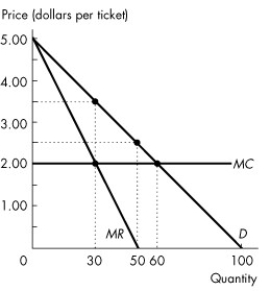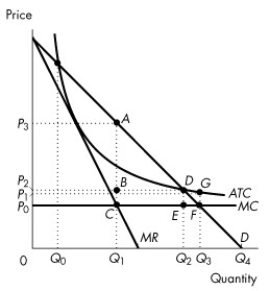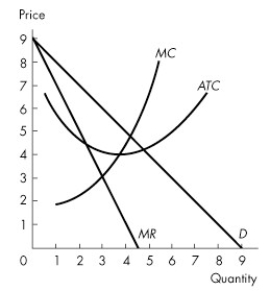A) sandwich shops
B) printing services
C) welding services
D) automotive service
E) electric utilities
G) None of the above
Correct Answer

verified
E
Correct Answer
verified
Multiple Choice
Use the figure below to answer the following questions.
 Figure 13.2.3
-Refer to Figure 13.2.3.Assume this firm is a single-price monopoly.How many tickets does this monopolist sell to maximize economic profit?
Figure 13.2.3
-Refer to Figure 13.2.3.Assume this firm is a single-price monopoly.How many tickets does this monopolist sell to maximize economic profit?
A) 20 tickets
B) 30 tickets
C) 50 tickets
D) 60 tickets
E) 100 tickets
G) A) and E)
Correct Answer

verified
Correct Answer
verified
Multiple Choice
An efficient use of resources occurs when
A) a deadweight loss arises.
B) total social benefit from a good equals its total social cost.
C) producer surplus is eliminated.
D) consumer surplus is maximized.
E) a monopoly practices perfect price discrimination.
G) B) and E)
Correct Answer

verified
D
Correct Answer
verified
Multiple Choice
Which of the following is least likely to be a natural monopoly?
A) subway services
B) electric utilities
C) water and sewer services
D) taxicab service
E) cable television services
G) A) and C)
Correct Answer

verified
Correct Answer
verified
Multiple Choice
Rate of return regulation can end up serving the self-interest of the firm if
A) there is a great demand for the good.
B) there is a competitive struggle to determine which firms will supply the market.
C) the regulated firm overstates its costs of production.
D) price is set at average total cost.
E) the rate is set too low.
G) None of the above
Correct Answer

verified
C
Correct Answer
verified
Multiple Choice
For the regulated natural monopoly, an average cost pricing rule sets price equal to
A) marginal cost.
B) total fixed cost.
C) average variable cost.
D) average fixed cost.
E) average total cost.
G) All of the above
Correct Answer

verified
Correct Answer
verified
Multiple Choice
Use the information below to answer the following questions. Fact 13.1.1 The following statements give some information about seven markets. 1. Coca-Cola cuts its price below that of Pepsi-Cola in an attempt to increase its market share. 2. A single firm, protected by a barrier to entry, produces a personal service that has no close substitutes. 3. A barrier to entry exists, but the good has some close substitutes. 4. A firm offers discounts to students and seniors. 5. A firm can sell any quantity it chooses at the going price. 6. The government issues Nike an exclusive licence to produce golf balls. 7. A firm experiences economies of scale even when it produces the quantity that meets the entire market demand. -Refer to Fact 13.1.1.The firm described in statement ________ is a natural monopoly.The firm described in statement ________ is a legal monopoly.
A) 7; 6
B) 2; 7
C) 6; 7
D) 2; 6
E) 1; 4
G) B) and D)
Correct Answer

verified
Correct Answer
verified
Multiple Choice
A single-price monopolist
A) maximizes economic profit by producing the quantity at which marginal revenue equals marginal cost.
B) maximizes economic profit by producing the quantity at which marginal revenue equals average total cost.
C) can increase the price and the quantity sold simultaneously.
D) is not restricted by the law of demand.
E) can sell as much as it wants at a given price because it is the only seller.
G) A) and D)
Correct Answer

verified
Correct Answer
verified
Multiple Choice
Capture theory states that
A) public officials favour consumers over producers.
B) regulations promote the attainment of an efficient outcome.
C) regulations lead to deadweight loss.
D) regulation eliminates economic profit.
E) rate of return regulation is best for all parties.
G) All of the above
Correct Answer

verified
Correct Answer
verified
Multiple Choice
The marginal revenue curve for a single-price monopoly
A) is below its demand curve.
B) is the same as the demand curve.
C) lies above its demand curve.
D) is horizontal.
E) has a slope equal to the slope of the demand curve.
G) A) and C)
Correct Answer

verified
Correct Answer
verified
Multiple Choice
Use the figure below to answer the following questions.
 Figure 13.3.4
-Consider the natural monopoly depicted in Figure 13.3.4.Total surplus is at a maximum when quantity is
Figure 13.3.4
-Consider the natural monopoly depicted in Figure 13.3.4.Total surplus is at a maximum when quantity is
A) Q₁ and price is P₁.
B) Q₁ and price is P₃.
C) Q₂ and price is P₂.
D) Q₃ and price is P₀.
E) Q₄ and price is 0.
G) None of the above
Correct Answer

verified
Correct Answer
verified
Multiple Choice
Use the figure below to answer the following questions.
 Figure 13.2.2
-Refer to Figure 13.2.2.If the single-price monopoly shown in Figure 13.2.2 is maximizing profit, what is total economic profit?
Figure 13.2.2
-Refer to Figure 13.2.2.If the single-price monopoly shown in Figure 13.2.2 is maximizing profit, what is total economic profit?
A) $3
B) $4
C) $6
D) $9
E) $7
G) A) and B)
Correct Answer

verified
Correct Answer
verified
Multiple Choice
Social interest theory states that
A) public officials favour consumers over producers.
B) regulations promote the attainment of an efficient outcome.
C) regulations promote the attainment of an inefficient outcome.
D) regulation maximizes economic profit.
E) rate of return regulation is best for all parties.
G) D) and E)
Correct Answer

verified
Correct Answer
verified
Multiple Choice
Canada Post has a monopoly on residential mail delivery.Pfizer Inc.makes LIPITOR, a prescription drug that lowers cholesterol.Rogers Communications is the sole provider of cable television service in some parts of Ontario.The monopolies which are legal monopolies are
A) only Pfizer.
B) Canada Post, Pfizer, and Rogers Communications.
C) Canada Post and Pfizer.
D) only Canada Post.
E) only Rogers Communications.
G) A) and C)
Correct Answer

verified
Correct Answer
verified
Multiple Choice
For a monopoly able to practice perfect price discrimination, the market
A) supply curve is horizontal.
B) supply curve is the same as the marginal revenue curve.
C) demand curve is the same as the marginal cost curve.
D) demand curve is the same as the marginal revenue curve.
E) demand curve is horizontal.
G) D) and E)
Correct Answer

verified
Correct Answer
verified
Multiple Choice
A perfect price-discriminating monopoly produces
A) less than a single-price monopoly.
B) more than a single-price monopoly but less than a perfectly competitive industry.
C) less than a monopoly that practices price discrimination but not perfect price discrimination.
D) more than a perfectly competitive industry.
E) the same amount as a perfectly competitive industry.
G) A) and B)
Correct Answer

verified
Correct Answer
verified
Multiple Choice
To prevent monopoly from arising, there must be
A) a single supplier of a good in the market.
B) no close substitutes for the good.
C) barriers preventing entry of other firms.
D) freedom of entry into the market.
E) economies of scale.
G) A) and D)
Correct Answer

verified
Correct Answer
verified
Multiple Choice
A monopoly
A) faces a perfectly elastic demand.
B) ignores the demand curve because it is the only seller.
C) can raise the price it charges only if it decreases the quantity that it sells.
D) can raise the price it charges only if it increases the quantity that it sells.
E) faces a perfectly inelastic demand.
G) A) and D)
Correct Answer

verified
Correct Answer
verified
Multiple Choice
Which of the following markets will have the largest deadweight loss?
A) a single-price monopoly
B) a perfectly competitive market
C) a perfectly price discriminating monopoly
D) both B and C
E) both A and C
G) B) and C)
Correct Answer

verified
Correct Answer
verified
Multiple Choice
A monopolist under marginal cost pricing has an incentive to
A) inflate costs.
B) produce more than the efficient quantity of output.
C) produce less than the efficient quantity of output.
D) maximize consumer surplus.
E) produce the efficient quantity of output.
G) A) and D)
Correct Answer

verified
Correct Answer
verified
Showing 1 - 20 of 118
Related Exams